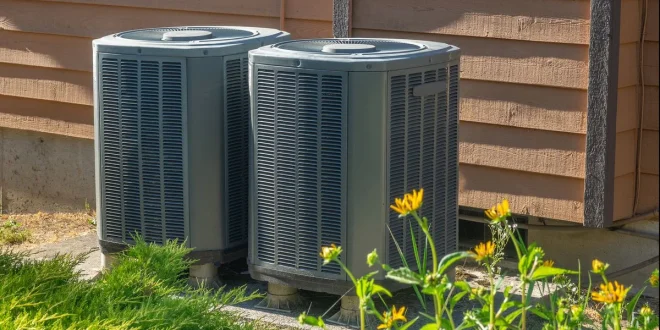Are you curious about how your home’s heating and cooling system works to make your living space comfortable all year round? In residential HVAC systems, one essential component is the heating duct.
This often-overlooked part is vital in maintaining optimal room temperature control and air quality. Join us as we explore the basics of heating ducts, their purpose, their components, and how they work to keep your home cosy during winter nights and refreshingly cool in the summer heat.
We’ll discuss the importance of proper installation and maintenance by HVAC professionals to ensure efficiency, safety, and cost savings for homeowners like you. You can also learn more about heating installation to understand the basics better.
Key Takeaways
- Heating ducts are essential components of HVAC systems that distribute warm or cool air to different rooms in a home, and proper installation and maintenance can improve energy efficiency, indoor air quality, and overall comfort.
- Components of heating ducts include the air handler, ductwork, dampers, registers or grilles, vents and diffusers. Efficient airflow and pressure within the ducts help ensure consistent temperature throughout your living space.
- Proper sizing of your heating/cooling ventilation system by an experienced HVAC professional can help maximize energy efficiency while minimizing costs. Regular maintenance such as cleaning filters and sealing leaks improves the lifespan of expensive equipment for safe operation. Homeowners should prioritize regular HVAC upkeep to protect their loved ones’ well-being & property investment from safety hazards such as carbon monoxide gas buildup or potential fire outbreaks due to combustible materials placed near vent/registers.
What Is A Heating Duct?
A heating duct, also known as a HVAC (Heating, Ventilation and Air Conditioning) duct, is an essential component of residential HVAC systems that carries warm or cool air from the heating or cooling system into different rooms throughout a home.
Basic Components
Heating ducts are typically made up of several basic components that work together to ensure proper airflow and temperature regulation throughout your home. These components include the air handler, which is responsible for heating or cooling the air, as well as the ductwork itself, which distributes that air to various rooms and spaces in your home.
Other important components of a heating duct system include dampers, which help regulate the airflow by opening or closing certain sections of the duct, and registers or grilles, which allow heated or cooled air to enter each room.
From the thermostat that controls the overall temperature of your home to individual vents and diffusers installed at strategic points throughout each room, every component plays an important role in keeping you comfortable year-round.
How Do Heating Ducts Work?
Heating ducts work by circulating warm air throughout your home, ensuring that each room is heated evenly. The airflow and pressure within the ducts are carefully controlled to maintain a consistent temperature throughout your living space.
Airflow And Pressure
Airflow and pressure are two critical components of a heating duct system. Efficient airflow ensures that your home’s heating or cooling is distributed evenly throughout every room, providing the desired level of comfort.
Pressure refers to the force required to maintain airflow through your HVAC system. Properly sized ducts help maintain optimal pressure levels, reducing stress on your HVAC unit and ensuring its longevity.
In summary, understanding how airflow and pressure work together in a heating duct system can help homeowners ensure their homes remain comfortable while also maximizing energy efficiency and minimizing maintenance costs.
Duct Sizing
Proper duct sizing is crucial to ensuring your HVAC system works efficiently. If your ductwork is too small, it can restrict airflow and make your heating or cooling system work harder than necessary.
There are several factors that determine the right size of ductwork for a room, including the type and size of the HVAC equipment, air pressure requirements, and the length and configuration of the ventilation system.
It’s important to consult with an experienced HVAC professional to determine what size of ducts will work best for your home.
When it comes to choosing an HVAC contractor for the installation or replacement of ductwork, look for someone who has experience in residential HVAC system design and installation as well as routine maintenance.
Efficiency And Maintenance
One important aspect of heating ducts is their efficiency and the need for proper maintenance. An HVAC professional can ensure that your system is running at its best, avoiding potential energy waste or loss of heat.
A poorly designed ductwork system may affect room temperature control and cost homeowners money in utility bills from inefficient heating or cooling systems. Regular HVAC maintenance can also improve indoor air quality by keeping dust and other debris from accumulating in the ducts, which could lead to respiratory problems and allergies.
Importance Of Proper Installation And Maintenance Of Heating Ducts
Proper installation and maintenance of heating ducts are crucial for several reasons. It ensures energy efficiency, improves air quality inside the house, saves costs, and prevents safety hazards.
Energy Efficiency
Proper installation and maintenance of your heating ducts can greatly improve your home’s energy efficiency. By having a well-designed duct system, airflow can be optimized to reduce energy waste and lower utility bills.
Regular maintenance, such as cleaning or replacing filters and sealing any leaks, can further improve the efficiency of your heating ducts. When your HVAC system operates at peak performance, you save money on energy bills and contribute to a greener planet by reducing carbon emissions.
Improved Air Quality
One of the often-overlooked benefits of properly installing and maintaining heating ducts is improved air quality.
In addition, regular cleaning and maintenance of your HVAC system can significantly improve indoor air quality by reducing the buildup of dust, pollen, pet dander, and other allergens in your home.
Overall, taking steps to maintain a well-designed heating duct system not only keeps your home comfortable but also promotes healthier living conditions for you and your family.
Cost Savings
Proper installation and maintenance of your heating ducts can help you save money on your utility bills. When there are leaks or blockages in your HVAC system, it has to work harder to circulate air throughout your home, resulting in higher energy consumption and costs. This can be addressed by regularly scheduling heating repair services to ensure everything is functioning optimally.
Replacing outdated or inefficient equipment with newer models can lead to significant cost savings. For example, upgrading from a standard thermostat to a programmable one can help reduce energy usage by automatically adjusting the temperature when no one is home or during sleeping hours.
Regular HVAC maintenance will also improve efficiency levels, prevent costly breakdowns, and prolong the lifespan of expensive equipment.
Safety Considerations
It is important to consider the safety factors that come with heating ducts. Poor installation and damaged or clogged ductwork can lead to a buildup of carbon monoxide gas, which is poisonous and potentially fatal.
Another safety consideration is ensuring that there are no flammable materials near the heating ducts. Make sure you keep combustible items like paper, clothing, or curtains away from vents and registers to prevent fires.
By prioritizing proper maintenance and taking necessary precautions regarding safety around heating ducts in your home, you can protect both your loved ones’ well-being and household property investments.
Conclusion
In conclusion, heating ducts are essential to residential HVAC systems because they help maintain comfortable indoor temperatures. Understanding the basics of a heating duct can help homeowners improve air quality, achieve energy efficiency, and lower costs in the long run.
Proper installation and maintenance by HVAC professionals ensure optimal airflow and pressure for efficient functioning.
 HammBurg Be informed with latest news, reviews, entertainment, lifestyle tips, and much more.
HammBurg Be informed with latest news, reviews, entertainment, lifestyle tips, and much more.




